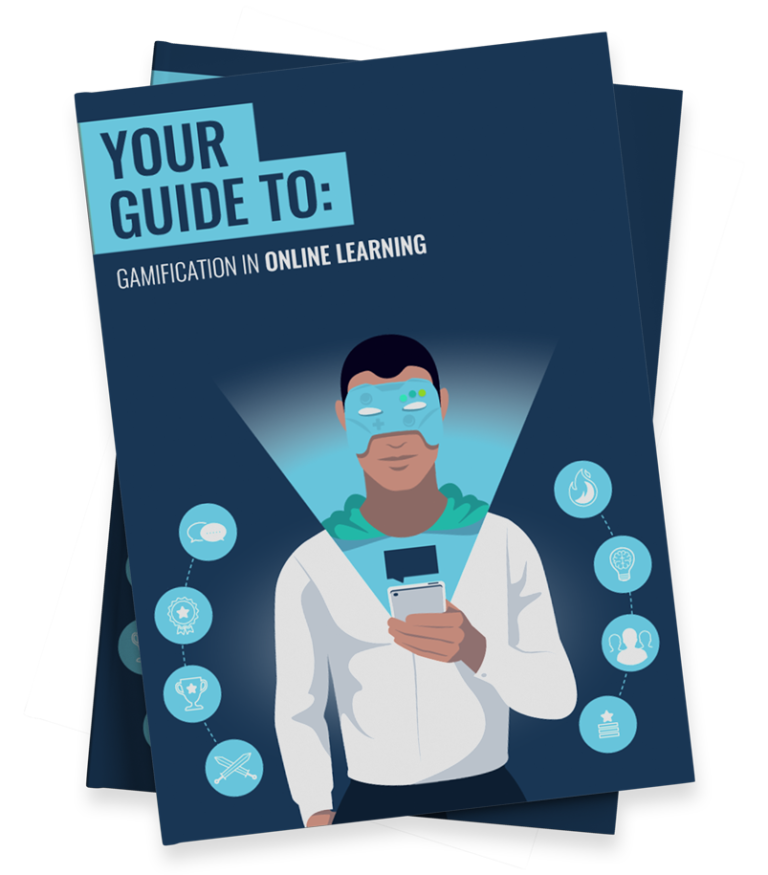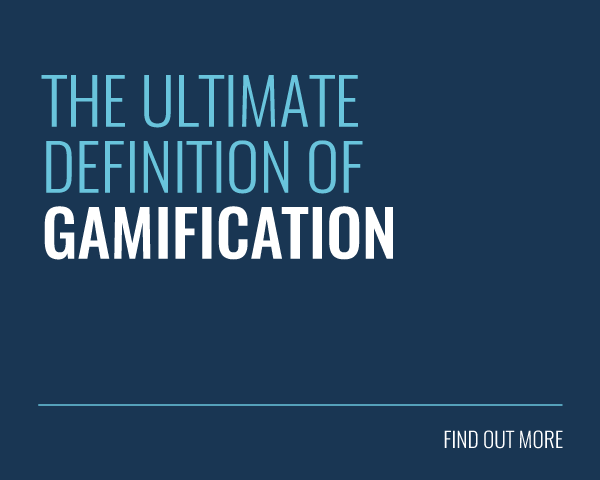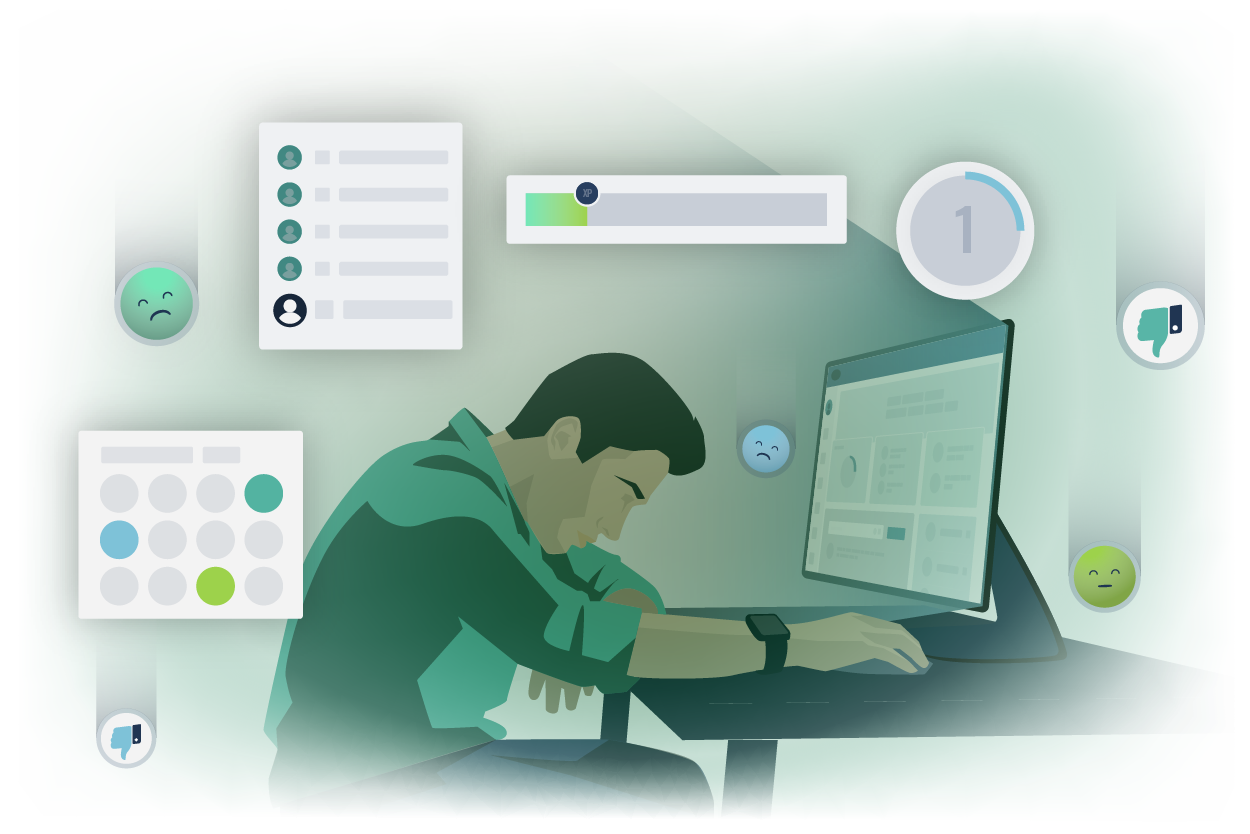
Gamification promises a world of engaged users and motivated learners. But all too often, that promise falls short, revealing a darker side where leaderboards demotivate, points feel pointless, and badges elbow genuine curiosity out of the way. It’s this dark side of gamification that we’re interested in today.
We’ll examine the ethics behind game mechanics, three ways this approach can backfire, and how we can reclaim this powerful methodology back from its critics.
As we’ll see, gamification without purpose is a dead-end. Indeed, thought leader Andrzej Marczewski puts it this way: ‘gamification should be a strategy, not an afterthought or add-on’. So, the real game begins now and it’s time to play it the right way.
What is Gamification?
Let’s start with a definition. After all, gamification is a powerful yet frequently misunderstood concept. At its core, gamification is the application of game mechanics and principles in non-game contexts to motivate and engage people.
As such, it’s not about turning everything into a full-fledged video game (contrary to popular opinion). Instead, it takes the most compelling and motivational parts of these games, and uses them to make everyday tasks more enjoyable. This includes:
- Experience Points: The most basic game mechanic. Points provide immediate feedback and a measurable sense of accomplishment.
- Badges: Visual symbols of mastery that celebrate the completion of specific tasks and the attainment of key milestones.
- Leaderboards: Public scoreboards that display player rankings, helping to foster healthy competition and social comparison.
- Levels: Visual indicators that show a user how far they’ve come and how far they still have to go, outlining their pathway to mastery.
- Streaks: A habit-forming mechanic that rewards consistent, daily engagement. For example ‘Log in 5 days in a row’.
- Contests: Player-vs-player challenges (like our knowledge quizzes) that provide users with a clear objective to work towards.
You likely encounter these mechanics every day, often without even realising it. For example, the Starbucks Rewards programme uses points (or ‘Stars’) and levels to turn coffee purchases into a game. Likewise, fitness apps like Strava and Fitbit use streaks and badges to motivate you to keep moving.
In other words, this isn’t just a passing trend. It’s a pervasive design strategy used to influence behaviour across a wide range of industries.
What’s more, gamification’s effectiveness is well supported by evidence. When implemented correctly, it can be extremely impactful. For instance:
- 90% of employees report that gamification makes them more productive at work.
- 95% of employees say they enjoy using gamified systems.
- And gamification has been shown to boost learner engagement by up to 60%. Wow!
The Ethics of Gamification

So, what’s the problem here? Isn’t more fun always better? Well, the issue is that when designed poorly, gamification doesn’t feel like a game. It feels like a manipulative system of control, straight out of a Black Mirror episode.
For instance, it’s hard to know how to feel about Amazon’s ‘dystopian gameboard’, which monitors how hard staff are working in their warehouses. While persuasive technologies can be effective in a learning context, the gamification of underpaid work feels exploitative and dehumanising.
This tension between engagement and manipulation is a constant in the real world. Snapchat popularised the ‘streak’ to encourage consistent communication, but it can also create a low-grade anxiety and a sense of obligation, especially for younger users.
Similarly, rating systems on apps like Uber or DoorDash can exert immense pressure on gig workers, while digital loyalty cards can trigger a fear of missing out and encourage compulsive purchasing behavior. When pushed too far, gamification simply becomes fun-free manipulation.
This highlights the crucial ethical dimension of the practice. It’s the ‘why’ and the ‘for whom’ behind these game mechanics that really matters. If they are applied in a way that is exploitative or fundamentally misaligned with the user’s well-being, then they must be rejected.
Learning, of course, is a distinctly different context. The ultimate purpose is to improve the user and gamification serves this end. It should make the joy of learning and mastery more visible and rewarding. It’s not a cage, it’s a pathway.
But, even with the best intentions, it’s still possible to get gamification wrong in a learning environment. We’ll explore these potential pitfalls next.
The Dark Side of Gamification Exposed
At Growth Engineering, we have championed gamification for over two decades. As a cornerstone of our success, it is a core feature across all three of our products. However, our philosophy has always been clear: we never advocate for gamification without a purposeful strategy behind it.
Indeed, when implemented without psychological nuance, gamification doesn’t just fail — it can actively damage motivation and trust. With this warning in mind, here are three of the most common ways it backfires.
Pitfall #1: The Overjustification Effect
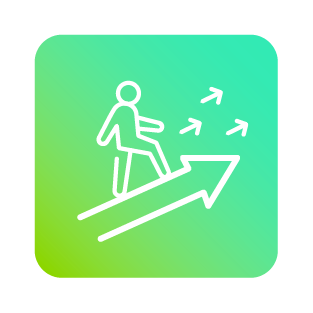
In a landmark 1971 study, psychologist Edward Deci (one of the masterminds behind Self-Determination Theory — more on this later) demonstrated a fundamental truth about motivation. Extrinsic rewards, such as money, can actually diminish a person’s intrinsic motivation to perform a task. Yikes.
This well-documented psychological phenomenon is known as the overjustification effect. It tells us that when you apply an external reward (like badges or points) to an activity that a person already finds interesting, you risk crowding out their natural joy in the process.
The danger of this approach is that once the external rewards dry up, or lose their meaning, a user’s motivation can collapse completely. You haven’t created a lifelong learner, you’ve created a points-addict who will leave when there’s no points left to gain.
Pitfall #2: The Leaderboard Loser Effect

Friendly competition can be a powerful motivator, and studies show that having a ‘rival’ is a major source of external motivation. However, competition also comes with its own set of challenges. Take the humble leaderboard for example. Does this game mechanic sometimes do more harm than good?
If a user sees themselves in 20th, 100th, or even 1000th place on the scoreboard with no hope of catching up, a rational response would be to stop playing. Why compete if you can’t win? This effectively disenfranchises the majority of users, alienating newcomers and those who are struggling to keep up.
As a uniquely public form of gamification, leaderboards also create a sense of social comparison that can lead to stress and anxiety. When your progress is publicly displayed against others, it can sometimes feel easier to check out than to play the game.
Pitfall #3: Pointless Pointification

A criticism of gamification that we often hear is that it doesn’t work for older, more professional audiences. Merely slapping on points, badges, and progress bars to existing activities can create a hollow and inauthentic experience that feels disconnected from any real value.
When a learner gets a badge for a trivial task like logging in to their learning management system or downloading a PDF, it devalues the entire approach. This is because the reward feels completely disconnected from the effort and achievement, rendering it meaningless.
At this stage, learners often begin to see through the facade, viewing the gamification as a transparent and manipulative tactic. As a result, its power is lost completely, and engagement levels are likely to plummet.
Rethinking Motivation
Clearly, the risk of gamification backfiring is real. But the solution isn’t to abandon game mechanics entirely. Instead, we need to be even more strategic. In fact, we need to return to the core principles of human motivation.
This foundation is best explained by Self-Determination Theory (SDT), a framework that identifies three essential human needs driving intrinsic motivation:
- Competence: This is our need to master skills and overcome challenges. Gamification can satisfy this by providing clear visual markers of progress, such as progress bars, levels, and badges, that signify a learner’s growing mastery.
- Autonomy: We all long to feel in control of our own actions and choices. Gamification can address this need by offering customisable learning paths, optional challenges, and choice-based activities that allow learners to have a say in their experience.
- Relatedness: Finally, we have a fundamental need to feel connected to others. Since motivation doesn’t exist in a vacuum, gamification can foster this sense of community through leaderboards, team challenges, and social features.
Many of gamification’s potential pitfalls stem from a failure to address one or more of these core psychological needs. For instance, pointification feels meaningless because it doesn’t link to a clear improvement in competence. Similarly, leaderboards can feel imposing when we don’t have the autonomy necessary to improve our standing.
The key, then, is to effectively tap into all three of these drivers. To do this, we need to focus squarely on intrinsic motivation (doing something because it’s inherently enjoyable) rather than extrinsic motivation (external rewards like grades or paychecks).
That’s the focus of our next section. Let’s rescue gamification from the abyss!
The Light Side of Gamification: Embracing Intrinsic Motivation
By shifting our focus from controlling behaviour to supporting psychological needs, we can engineer experiences that are both engaging and empowering. With that in mind, here’s how you can transform those previously mentioned pitfalls into powerful principles:
Overcoming The Overjustification Effect

Naturally enough, the key to avoiding overjustification is to avoid extrinsic motivators. Your rewards should serve intrinsic motivation, not sabotage it. This requires a deliberate design strategy where rewards are:
- Informational: Where possible, frame your rewards as feedback. For instance, ‘You earned the ‘Compliance Champion’ badge because you mastered all five advanced security modules!’. This helps to tell the story of your learners’ growth.
- Mastery Focused: Take care to reward effort and persistence, rather than simple participation. After all, a badge for getting a perfect quiz score is more meaningful than one for merely having clicked ‘Start’.
- A True Celebration: Design rewards to feel like a recognition of achievement, not a transaction. Take care to preserve the inherent value of the learning itself in all your communications and touchpoints.
Levelling Up Your Leaderboards

As we’ve seen, leaderboards can offer a mixed bag of motivation. When structured properly, a leaderboard should inspire healthy competition, not entrench a hierarchy of winners and losers. Here’s how you can achieve this lofty goal:
- Time-bound Boards: While keeping an ‘all-time’ record can be useful for your top performers, you should always provide filtering options so learners can view their standing on a daily, weekly, and monthly basis. This gives everyone a regular chance to win.
- Most Improved Boards: Go further, by featuring a ‘Most Improved’ leaderboard alongside your ‘Top Performers’. This celebrates growth and motivates those who are new and are just starting to climb the ranks.
- Team-focused Boards: Shift the focus from individual glory to team achievements. For instance, why not implement leaderboards showing department vs. department or branch vs branch progress? This can help to reduce the sting of individual loss.
Powering-Up Your Points

Game mechanics only have meaning when they’re integrated into a larger, purposeful system. Without this, experience points (and other game elements) become an empty metric. Thankfully, there’s a few ways you can prevent this from happening:
- Forge a Narrative: Find your ‘epic meaning’ by placing your entire learning pathway within a story or theme. For example, learners on your cybersecurity training platform could collect ‘intel points’, helping them to climb ‘clearance levels’.
- Points for Progress: Ensure your points directly contribute to levelling up or unlocking new content. This ties effort (earning points) to tangible advancement within the learning environment, making them a clear indicator of progress.
- Add Autonomy: Consider making points a currency for meaningful choices. For instance, learners could spend these points on further content, power-ups, or access to exclusive resources. This puts power back in learners’ hands.
Finally, don’t forget to design your mechanics in a way that connects people, encourages collaboration, and builds community. For gamification to succeed, these social drivers must be firmly embedded within your learning management system (LMS).
At Growth Engineering, we even use Knowledge Contests (learner-vs-learner quizzes) that challenge users to demonstrate their subject matter mastery. These contests offer participants not only additional XP and badges, but also the chance for a rewarding and competitive experience.
What better way to encourage learning than to make it a shared, social event?
Final Words
Yes, gamification has a ‘dark side’. But this is a failure of design and ethics, not of the methodology itself.
After all, the ultimate goal of ethical gamification is to act as a scaffold. Initially the game-like elements provide learners with the structure and motivation they need to engage with your content.
Over time, as the learner grows in competence, autonomy, and relatedness, this scaffolding can fade away. As a result, the mechanics didn’t ‘trick’ them into learning. They simply revealed the value and joy that is inherent in the process.
That’s the light side of gamification. When used with ethical intent and designed to avoid common pitfalls, it becomes a powerful tool that cultivates genuine, self-sustaining motivation. This is how you engineer engagement. Game on!
Thanks for reading. If you’ve enjoyed this content, please connect with me here or find more articles here.
Gamification is a powerful tool, but only with the right strategy. Stop guessing and start building. Download our Gamification Guidebook and learn the proven framework for designing engagement that lasts.

